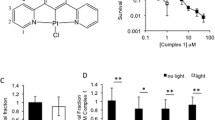Abstract
Camptothecin (CPT) is an anticancer drug that inhibits topoisomerase I (Topo I) by forming a ternary DNA-CPT-Topo I complex. However, it has also been shown that UVA-irradiated CPT in the absence of Topo I produces significant DNA damage to cancer cells. In this work, we explored and identified free radicals generated in these processes. From the low-temperature EPR spectrum of Cu(II)-CPT complex, a proximity between Cu(II) ion and 20-hydroxy group of lactone E ring of CPT is proposed. Upon irradiation (λ = 365 nm) of the Cu(II)-CPT complex in de-oxygenated dimethylsulfoxide (DMSO), the EPR signal of Cu(II) measured in situ at room temperature shows formal first-order exponential decay with a formal half-life of 11 min. By the use of a specific Cu(I) chelating agent, neocuproine, it was shown that, during this process, Cu(II) is reduced to Cu(I). The loss in EPR signal intensity of the Cu(II)-CPT complex upon irradiation is accompanied by the appearance of a new EPR signal at g ≈ 2.0022. Application of the spin trap nitrosodurene (ND) revealed that the main radical product formed upon continuous irradiation of CPT in DMSO solutions is the hydroxyl radical (trapped in DMSO as the •CH3 adduct) and superoxide radical. Application of 2,2,6,6-tetramethyl-4-piperidinol has revealed that irradiation of CPT in aerated DMSO solution also leads to formation of singlet oxygen (1O2). Our spectroscopic experiments indicate that CPT is a promising photosensitizer and that radicals and singlet oxygen generated upon illumination play a central role in DNA cleavage and in the induction of apoptosis in cancer cells.


Similar content being viewed by others
References
Burke, T. G., & Mi, Z. (1993). Ethyl substitution at the 7-position extends the half-life of 10-hydroxycamptothecin in the presence of human serum-albumin. Journal of Medicinal Chemistry, 36, 2580–2582.
Wiseman, L. R., & Markham, A. (1996). Irinotecan—A review of its pharmacological properties and clinical efficacy in the management of advanced colorectal cancer. Drugs, 52, 606–623.
Hertzberg, R. P., Caranfa, M. J., & Hecht, S. M. (1989). On the mechanism of topoisomerase-i inhibition by camptothecin—evidence for binding to an enzyme DNA complex. Biochemistry, 28, 4629–4638.
Kuwahara, J., Suzuki, T., Funakoshi, K., & Sugiura, Y. (1986). Photosensitive DNA cleavage and phage inactivation by copper(ii) camptothecin. Biochemistry, 25, 1216–1221.
Brezová, V., Valko, M., Breza, M., Morris, H., Telser, J., Dvoranová, D., Kaiserová, K., Varečka, L., Mazúr, M., & Leibfritz, D. (2003). Role of radicals and singlet oxygen in photoactivated DNA cleavage by the anticancer drug camptothecin: An electron paramagnetic resonance study. Journal of Physical Chemistry B, 107, 2415–2425.
Staško, A., Szaboová, K., Cholvad, V., Nuyken, & O., Dauth, J. (1993). The photochemical decomposition of azo-compounds (a spin trap study). Journal of Photochemistry and Photobiology A-Chemistry, 69, 295–304.
Hirahara, Y., Okuno, T., Ueno, H., & Nakamuro, K. (2003). Photooxidation mechanism of fenthion by singlet oxygen: Evidence by ESR analysis with a selective spin trapping agent. Journal of Health Science, 49, 34–39.
Acknowledgements
We thank the Grant Agency for financial support (Projects VEGA 1/2450/05 and VEGA 1/3579/06).
Author information
Authors and Affiliations
Corresponding author
Rights and permissions
About this article
Cite this article
Brezová, V., Dvoranová, D., Žúbor, V. et al. Photochemical Properties of Camptothecin in the Presence of Copper(II) Ions: The Role of Radicals as Prospective Species in Photodynamic Therapy. Mol Biotechnol 37, 48–51 (2007). https://doi.org/10.1007/s12033-007-0050-0
Published:
Issue Date:
DOI: https://doi.org/10.1007/s12033-007-0050-0




